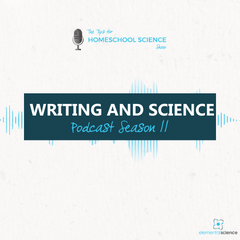 Several months ago, I shared with you the three keys for teaching science. I wanted to come back and address each of the essentials in greater detail. For review, here are the three essentials:
Several months ago, I shared with you the three keys for teaching science. I wanted to come back and address each of the essentials in greater detail. For review, here are the three essentials:
- Performing Hands-on Scientific Tests
- Gathering Information
- Keeping a Record
Today, we are going to look closer at Essential #3 – Keeping a Record.

WHY DO YOU NEED TO KEEP A RECORD?
Studies have shown that the act of writing down information or taking notes increases a person’s ability to remember that data.
Keeping a record gives our students another chance to interact with the information. It provides them another touch-point that helps to firmly affix the material into their minds.
Writing it down also provides material for the student to review for testing or in the future years.
HOW DO YOU KEEP A RECORD?
You will have two streams of information from the first two keys. Your students can record what they have done through their hands-on scientific tests, and they can record the information they have gathered.
RECORDING HANDS-ON SCIENTIFIC TESTS
Hands-on scientific tests are very visual, which already helps to pin the information into the students’ memories. However, it is beneficial to also have the students write down what they have learned while performing these tests.
The method you use to hands-on scientific tests will depend largely on the type of test you did. You can use:
-
Nature Journals – The nature journal is a personal record of what the student has learned during their nature study time. We generally recommend that you have the students record at least one scientific fact, the date, and the place as part of their nature journal page.
-
Lab Reports & Experiment Sheets – Lab reports are simple records of what the elementary students have seen and learned during a demonstration or experiment. Experiments sheets are a more complete record of what the students have seen and done during an experiment.
The detail the students include in the records will depend on upon their age. In other words, the older they are the more detailed their nature journals and experiment sheets will be.
RECORDING INFORMATION
Your students will be gathering information through books and videos to learn about science. Having them record portions of this information will serve to solidify the facts into their minds.
You can use:
- Oral Narration/Dictation
- Notebooking
- Lapbooks
- Comprehension worksheets
- List of Facts
- Outlines
- Sketches
What you use and how many times you record information each week will depend on upon your students’ ages.
In the early years, you can use oral narration, notebooking, and lapbooks several times a week. The students will not actually write much in the beginning but increase the amount with their abilities.
As they mature, you can use notebooking, comprehension worksheets, a list of facts, outlines, and sketches. Again, the amount they write will increase with their abilities.
We prefer notebooking for a number of reasons, most of which are detailed in this post – why choose notebooking over worksheets.
TIPS FOR SUCCEEDING AT KEEPING A RECORD
Tip #1 - Make it easy.In other words, don’t push your students to write beyond their abilities in science. You don’t want your students to end up hating science simply because they have to write it down. The writing you do in science should reinforce what your students have already learned to do in writing.
Tip #2 - Make it fun.Switch up the type of writing you require. One unit you can have them do a notebooking page, the next unit you can have them make a lapbook. Changing the type of writing you require can keep things fun and fresh.
Tip #3 - Make it visual.Adding cut out pictures, photos, or drawings serve to provide another connection to the material for your students. Plus, it makes their work interesting and appealing to share with others!
If you have any questions about how to keep a record, head on over to Facebook or Google+ and join the conversation.
This article was written by our author,Paige Hudson. You can also find her mixing up solutions for homeschool science atElemental Blogging. If you want to receive more articles just like this, plus our monthly discounts, sign up for our newsletter in the box below orclick here.
Need help with planning the record-keeping aspect of homeschool science?Come see how we can help!



 Several months ago, I shared with you the
Several months ago, I shared with you the 



